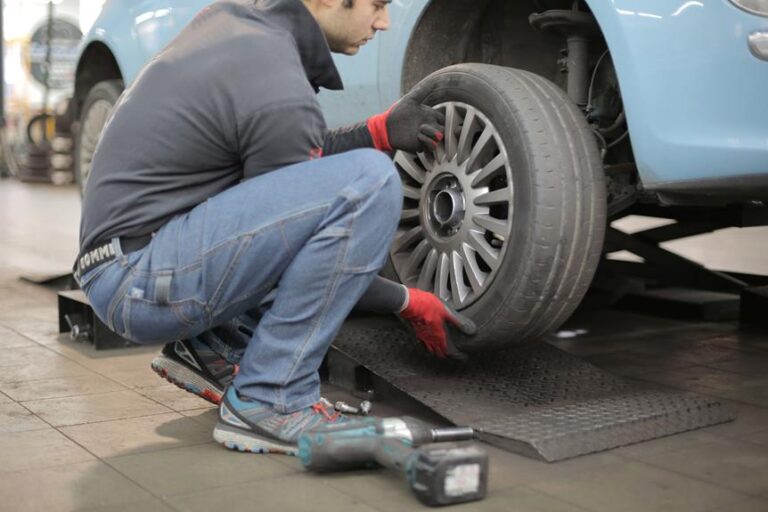Monitoring Tread Depth With Gauges
In the realm of tire maintenance, monitoring tread depth is a critical aspect that should not be overlooked. By using precision instruments such as tread depth gauges, one can accurately assess the wear patterns and condition of their tires.
This article aims to provide valuable insights into the importance of tread depth, the benefits of using gauges, different types of gauges available, and proper techniques for measuring tread depth.
By maintaining optimal tread depth, drivers can ensure enhanced safety and performance on the road.
Key Takeaways
- Adequate tread depth is important for traction and accident prevention.
- Regular tire maintenance ensures optimal performance and safety.
- Tread wear patterns provide insights into tire condition and potential issues.
- Tread depth gauges provide accurate measurements for precise monitoring.
The Importance of Tread Depth
The importance of maintaining adequate tread depth on vehicle tires cannot be overstated, as it directly impacts the vehicle's ability to maintain traction and prevent accidents. Regular tire maintenance is crucial to ensure optimal performance and safety on the road. Tread depth refers to the measurement between the top of the tire tread and the deepest groove. It is a key indicator of tire condition and affects the tire's ability to grip the road surface.
Driving with worn-out tires can have severe consequences. Reduced tread depth leads to decreased traction, especially on wet or slippery surfaces. This can result in longer stopping distances, increased risk of hydroplaning, and compromised handling. Additionally, worn-out tires are more prone to punctures and blowouts, further jeopardizing the safety of the vehicle and its occupants.
Regular tire maintenance, including monitoring tread depth, is essential to avoid these risks. Checking tread depth using specialized gauges allows drivers to determine when tires need to be replaced. It is recommended to replace tires when the tread depth reaches 4/32 of an inch, as this is the point where traction begins to significantly diminish.
Understanding Tread Wear Patterns
Understanding tread wear patterns is essential for maintaining optimal tire performance and safety.
Common tread wear patterns can provide valuable insights into the overall condition of the tires and potential issues that need to be addressed.
Common Tread Wear Patterns
An awareness of the various tread wear patterns is essential for accurately assessing tire condition and ensuring optimal vehicle performance. By understanding these patterns, drivers can identify potential issues and take appropriate measures to prevent uneven wear. Here are three common tread wear patterns and their causes:
| Tread Wear Pattern | Description | Cause |
|---|---|---|
| Center Wear | Excessive wear in the center of the tire tread, while the outer edges remain relatively untouched. | Overinflation of tires, leading to increased pressure on the center of the tread. |
| Edge Wear | Excessive wear on the outer edges of the tire tread, while the center remains relatively intact. | Underinflation of tires, causing increased pressure on the outer edges. |
| Cupping | Irregular wear characterized by scalloped or cup-shaped depressions on the tread surface. | Suspension or alignment issues, causing uneven contact with the road surface. |
Regular tire rotation techniques can help prevent these wear patterns by distributing the forces evenly across all tires. Additionally, maintaining proper tire inflation and regularly inspecting tread depth can further extend tire life and ensure safe driving conditions.
Causes of Uneven Wear
Excessive wear on the outer edges of the tire tread and cupping are two common causes of uneven wear. These issues can arise due to a variety of factors, including causes of tire imbalance and the impact of road conditions.
Causes of tire imbalance can include improper tire inflation, misalignment, or worn suspension components. When a tire is not properly balanced, it can lead to uneven wear on certain areas of the tread.
Additionally, road conditions such as potholes, rough surfaces, and debris can also contribute to uneven wear. These factors can cause the tire to wear unevenly, resulting in reduced performance and potentially compromising the safety of the vehicle.
Regular monitoring of tire wear and addressing any imbalances or issues promptly can help to ensure proper tire performance and longevity.
Benefits of Using Tread Depth Gauges
Using tread depth gauges offers several benefits for monitoring tire wear.
Firstly, these gauges provide accurate measurements, allowing for precise monitoring of tread depth over time.
This enables early detection of balding, allowing drivers to take proactive measures to replace worn-out tires before they become unsafe.
Ultimately, the use of tread depth gauges helps ensure optimal tire performance and safety on the road.
Accurate Tire Wear Measurement
Accurate tire wear measurement can be achieved through the precise utilization of tread depth gauges for effective monitoring. These gauges are essential tools that enable us to accurately measure the depth of the tire tread, allowing us to assess the wear and tear on the tires.
By employing accurate measurement techniques, we can identify any signs of premature wear and take appropriate measures to prevent further damage. Tread depth gauges provide precise measurements, allowing us to determine the remaining tread depth and assess the need for tire replacement.
This enables us to maintain optimal tire performance and ensure the safety of the vehicle and its occupants. By regularly monitoring tire wear with the help of tread depth gauges, we can prevent premature wear, prolong tire life, and optimize vehicle efficiency.
Early Detection of Balding
Regularly employing tread depth gauges allows for timely identification of balding, enhancing the early detection of tire deterioration and facilitating proactive measures for maintenance and replacement.
Tires with insufficient tread depth pose a significant safety risk, particularly in wet or icy conditions. By using tread depth gauges, drivers can monitor the wear pattern and measure the depth of their tire treads accurately. This information provides an early warning system for potential tire failure, allowing drivers to take preventative measures before it becomes a safety concern.
Regularly checking tread depth also ensures optimal performance and fuel efficiency. If the measurements indicate excessive wear, drivers can take proactive steps such as rotating tires, aligning wheels, or replacing the tires altogether.
Different Types of Tread Depth Gauges
A comprehensive understanding of the various classifications of tread depth gauges is essential for accurate tire maintenance and monitoring. Tread depth gauges are used to measure the depth of the tread on tires, providing valuable information about their condition and performance. There are several types of tread depth gauges available, each with its own pros and cons.
One type of tread depth gauge is the manual gauge, which requires physical contact with the tire to measure the tread depth accurately. These gauges are simple to use and provide accurate results. However, they can be time-consuming when measuring multiple tires and may require frequent calibration to maintain accuracy.
Another type of gauge is the digital gauge, which uses electronic sensors to measure the tread depth. These gauges are more convenient to use as they provide quick and precise measurements. They often come with additional features like memory storage and data analysis. However, digital gauges can be more expensive compared to manual gauges, and they may require batteries or charging.
Lastly, there are tread depth gauges integrated into tire pressure monitoring systems (TPMS). These gauges provide real-time tread depth information along with tire pressure readings. They offer the advantage of continuous monitoring without the need for manual measurements. However, TPMS-based tread depth gauges can be costly and require professional installation.
How to Measure Tread Depth Correctly
To ensure precise measurements, it is crucial to adhere to the proper technique when determining tread depth using a reliable gauge. Accurately measuring tread depth is essential for maintaining safe driving conditions and extending the lifespan of tires. Using a tread depth gauge allows for precise measurements, ensuring that the depth is within the recommended range. Here is a table outlining the proper use of tread depth gauges:
| Step | Procedure | Description |
|---|---|---|
| 1 | Select the appropriate tread depth gauge | Choose a gauge that is suitable for the type of tire being measured. |
| 2 | Place the gauge into the tire's grooves | Insert the gauge into several locations across the tire, ensuring it rests flush against the tread surface. |
| 3 | Read the measurement | Look at the gauge's indicator to determine the tread depth. |
| 4 | Repeat the process for all tires | Measure the tread depth of each tire individually, including the spare tire. |
| 5 | Compare the measurements to the recommended depth | Check the measurements against the manufacturer's recommended tread depth. |
Signs of Worn-Out Tires
One common sign of worn-out tires is when they start to exhibit irregular tread wear patterns, which can indicate a need for replacement. Tread wear patterns can vary depending on factors such as tire alignment, tire pressure, and driving habits. Some common irregular tread wear patterns include cupping, feathering, and scalloping.
Cupping refers to the formation of small, rounded depressions on the tread surface, which occurs when the tire bounces excessively. Feathering is characterized by the tread blocks wearing down on one side, creating a feather-like pattern. Scalloping, also known as cupping or pitting, is the formation of small, scallop-shaped depressions on the tread surface.
Regular tire maintenance is crucial for ensuring optimal performance and safety. By regularly inspecting the tread wear patterns, drivers can identify signs of worn-out tires and take necessary action, such as tire replacement. It is recommended to check the tread depth using a tire tread depth gauge. The recommended tread depth for different vehicles may vary, but generally, a minimum tread depth of 2/32 inch is considered the legal limit. However, for improved traction and safety, it is advisable to replace tires with a tread depth of 4/32 inch or less.
In the subsequent section, we will discuss the recommended tread depth for different vehicles and its importance in maintaining optimal tire performance and safety.
Recommended Tread Depth for Different Vehicles
The recommended tread depth for different vehicles can vary based on factors such as weather conditions and driving habits, but it is essential to prioritize safety by ensuring an adequate tread depth.
Here are four important considerations when determining the recommended tread depth for different vehicles:
- Weather Conditions: In areas with heavy rainfall or snowy winters, it is crucial to have deeper tread to maintain traction and prevent hydroplaning or slipping on icy surfaces.
- Driving Habits: Drivers who frequently encounter off-road or rough terrain should have deeper tread to provide better grip and stability. On the other hand, drivers who primarily drive on highways or well-maintained roads may require less tread depth.
- Recommended Tire Pressure: Maintaining the correct tire pressure is vital for optimal performance and safety. Underinflated tires can lead to premature wear and reduced tread depth, while overinflated tires may cause uneven wear and decreased traction.
- Tire Rotation Frequency: Regularly rotating your tires can help ensure even wear and extend their lifespan. By switching the tires from one position to another, you can promote more balanced tread depth across all four tires.
Overall, it is important to consult your vehicle's manufacturer or a tire professional to determine the recommended tread depth based on your specific driving conditions and habits. By prioritizing safety and maintaining adequate tread depth, you can enjoy a smoother and safer driving experience.
Maintaining Tread Depth for Enhanced Safety
Regularly inspecting and measuring tread depth, as well as promptly replacing worn tires, can help ensure enhanced safety on the road. Maintaining tire grip is crucial for safe driving, as it directly affects the vehicle's traction and handling.
Tread depth is the measurement of the space between the top of the tread and the deepest groove. Adequate tread depth is essential for proper water dispersion, which reduces the risk of hydroplaning and improves grip on wet surfaces.
To maintain tire grip, it is important to regularly check the tread depth using a tread depth gauge. This tool allows for accurate measurement of the tread depth, ensuring that it meets the recommended minimum depth. The minimum tread depth varies depending on the jurisdiction, but it is generally recommended to have a minimum of 3/32 of an inch.
In addition to using a tread depth gauge, there are other tread depth maintenance techniques that can be employed. These include rotating the tires regularly to ensure even wear, checking for signs of uneven wear, and avoiding over or under inflation of the tires.
Over time, the tread will naturally wear down, so it is important to monitor the tread depth and replace tires when they reach the minimum depth. By following these maintenance techniques, drivers can ensure that their tires maintain optimal grip, enhancing safety on the road.
Frequently Asked Questions
Can I Use a Coin to Measure Tread Depth Instead of a Tread Depth Gauge?
Using a coin to measure tread depth accuracy as an alternative to a tread depth gauge has its pros and cons. While it may provide a rough estimate, it lacks the precision and reliability of a specialized tool.
How Often Should I Check My Tire Tread Depth?
Regularly monitoring tire tread depth is crucial for safe driving. Methods to accurately measure tread depth include using a tread depth gauge or the "penny test". Signs of uneven tire wear can indicate the need for immediate inspection and potential replacement.
What Are the Consequences of Driving With Insufficient Tread Depth?
Driving with insufficient tread depth can lead to severe safety hazards, jeopardizing the driver's control over the vehicle and increasing the risk of accidents. It is crucial to monitor tread depth regularly to ensure timely tire replacement for optimal safety.
Can Tread Wear Patterns Indicate Other Issues With My Vehicle?
Tread wear patterns can indicate other issues with a vehicle, such as alignment problems or suspension issues. Regularly inspecting tread wear indicators and following tire maintenance tips can help identify and address these potential issues, ensuring optimal vehicle performance and safety.
Are There Any Alternative Methods to Maintain Tire Tread Depth Other Than Regular Inspections?
Automated tread depth measurement and tire tread depth monitoring systems are effective alternatives to regular inspections for maintaining tire tread depth. These methods provide accurate and reliable results, ensuring optimal safety and performance.
Conclusion
In conclusion, monitoring tread depth is crucial for ensuring optimal safety on the road. By understanding tread wear patterns and utilizing tread depth gauges, drivers can accurately measure the depth of their tires and identify signs of wear.
Maintaining the recommended tread depth for different vehicles is essential for enhanced safety and performance. Remember, worn-out tires can compromise vehicle handling and increase the risk of accidents.
So, take the necessary steps to maintain proper tread depth and keep yourself and others safe on the road.







